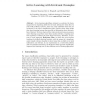Free Online Productivity Tools
i2Speak
i2Symbol
i2OCR
iTex2Img
iWeb2Print
iWeb2Shot
i2Type
iPdf2Split
iPdf2Merge
i2Bopomofo
i2Arabic
i2Style
i2Image
i2PDF
iLatex2Rtf
Sci2ools
ECML
2006
Springer
2006
Springer
Active Learning with Irrelevant Examples
Abstract. Active learning algorithms attempt to accelerate the learning process by requesting labels for the most informative items first. In real-world problems, however, there may exist unlabeled items that are irrelevant to the user's classification goals. Queries about these points slow down learning because they provide no information about the problem of interest. We have observed that when irrelevant items are present, active learning can perform worse than random selection, requiring more time (queries) to achieve the same level of accuracy. Therefore, we propose a novel approach, Relevance Bias, in which the active learner combines its default selection heuristic with the output of a simultaneously trained relevance classifier to favor items that are likely to be both informative and relevant. In our experiments on a real-world problem and two benchmark datasets, the Relevance Bias approach significantly improved the learning rate of three different active learning approa...
Related Content
| Added | 22 Aug 2010 |
| Updated | 22 Aug 2010 |
| Type | Conference |
| Year | 2006 |
| Where | ECML |
| Authors | Dominic Mazzoni, Kiri Wagstaff, Michael C. Burl |
Comments (0)

